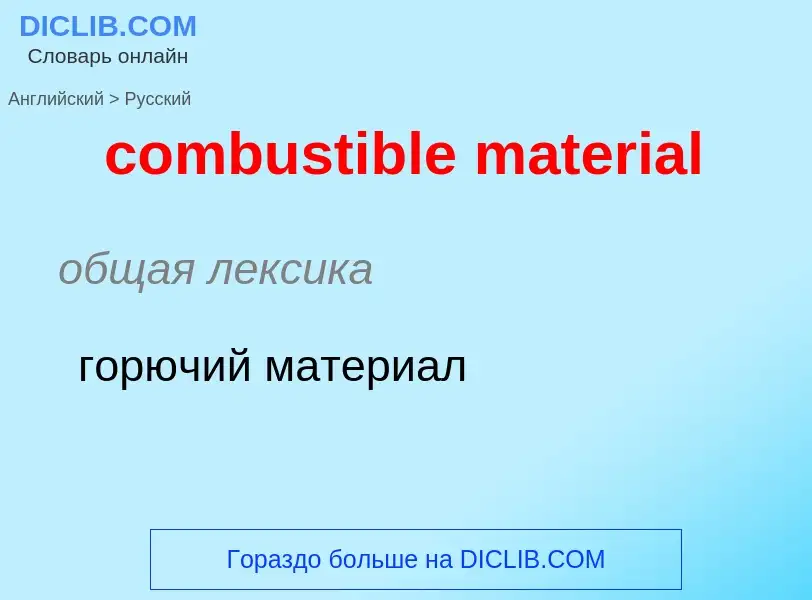Перевод и анализ слов искусственным интеллектом ChatGPT
На этой странице Вы можете получить подробный анализ слова или словосочетания, произведенный с помощью лучшей на сегодняшний день технологии искусственного интеллекта:
- как употребляется слово
- частота употребления
- используется оно чаще в устной или письменной речи
- варианты перевода слова
- примеры употребления (несколько фраз с переводом)
- этимология
combustible material - перевод на русский
общая лексика
горючий материал
строительное дело
невоспламеняющийся, невозгораемый
[kəmbʌstə'biliti]
общая лексика
воспламеняемость
горючесть
возгораемость
существительное
общая лексика
горючесть
воспламеняемость
горючесть, воспламеняемость
[flæmə'biliti]
общая лексика
воспламеняемость
строительное дело
возгораемость, воспламеняемость
существительное
техника
воспламеняемость
огнеопасность
['flæməb(ə)l]
общая лексика
горючий
огнеопасное вещество
огнеопасный
прилагательное
общая лексика
воспламеняемый
огнеопасный
существительное
общая лексика
огнеопасный
легковоспламеняющийся
[nɔn'flæməb(ə)l]
общая лексика
невоспламеняющийся
прилагательное
общая лексика
невоспламеняющийся
невоспламеняемый
Википедия

A flammable material is something that can burn (i.e., sustain a flame) in air under certain conditions. A flammable material is flammable if it ignites easily at ambient temperatures. In other words, a combustible material ignites with some effort and a flammable material catches fire immediately on exposure to flame.
The degree of flammability in air depends largely upon the volatility of the material - this is related to its composition-specific vapour pressure, which is temperature dependent. The quantity of vapour produced can be enhanced by increasing the surface area of the material forming a mist or dust. Take wood as an example. Finely divided wood dust can undergo explosive flames and produce a blast wave. A piece of paper (made from wood) catches on fire quite easily. A heavy oak desk is much harder to ignite, even though the wood fibre is the same in all three materials.
Common sense (and indeed scientific consensus until the mid-1700s) would seem to suggest that material "disappears" when burned, as only the ash is left. In fact, there is an increase in weight because the flammable material reacts (or combines) chemically with oxygen, which also has mass. The original mass of flammable material and the mass of the oxygen required for flames equals the mass of the flame products (ash, water, carbon dioxide, and other gases). Antoine Lavoisier, one of the pioneers in these early insights, stated that Nothing is lost, nothing is created, everything is transformed, which would later be known as the law of conservation of mass. Lavoisier used the experimental fact that some metals gained mass when they burned to support his ideas.



![DIN4102 A2 [[gypsum]] [[fireproofing]] [[plaster]] leavened with [[polystyrene]] beads DIN4102 A2 [[gypsum]] [[fireproofing]] [[plaster]] leavened with [[polystyrene]] beads](https://commons.wikimedia.org/wiki/Special:FilePath/Tu braunschweig din4102 smoke density test.jpg?width=200)
![penetration]] penetration]]](https://commons.wikimedia.org/wiki/Special:FilePath/Toilet flange.jpg?width=200)

![DIN 4102 B3: Polyurethane foam (easy to ignite = many [[hydrocarbon]] bonds usually) DIN 4102 B3: Polyurethane foam (easy to ignite = many [[hydrocarbon]] bonds usually)](https://commons.wikimedia.org/wiki/Special:FilePath/Polyurethane foam at inniskillin 2.jpg?width=200)
